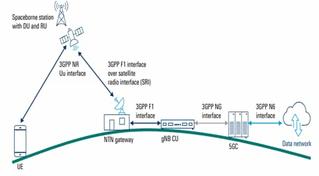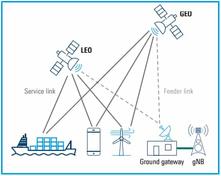NTN Frequency Bands:n254,n255,n256,n510,n511,n512
Advertisement
Introduction : As 5G evolves beyond terrestrial coverage, Non-Terrestrial Networks (NTN) are enabling ubiquitous connectivity via satellite and high altitude platforms. A fundamental enabler of NTN is the allocation of dedicated frequency bands that support the unique propagation, regulatory, and hardware constraints of satellite links.
In 3GPP Rel-17 and beyond, new band definitions (e.g. n255, n256) and proposals (n254, n510, n511, n512) aim to bridge the gap between terrestrial 5G and satellite access. These bands span lower frequency L/S bands for broad coverage, and higher frequency Ka band proposals for high capacity backhaul and fixed terminals.
| Frequency Band | Uplink/Downlink range | Duplex | Remark (if any) |
|---|---|---|---|
| n255 (L-band) | UL : 1626.5-1660.5 MHz, DL:1525-1559 MHz | FR1, FDD | Introduced in Rel-17 as NTN band in FR1 |
| n256 (S-band) | UL: 1980 – 2010 MHz, DL: 2170 – 2200 MHz | FR1, FDD | Introduced in Rel-17 for NTN use. |
| n254 (Extended L/S Hybrid band) | UL: 1610 – 1626.5 MHz, DL: 2483.5 – 2500 MHz | FR1, FDD | Proposed in Rel-18 for NTN (extension). |
| n510 (Ka/ higher NTN band) | UL: 27.5 GHz – 28.35 GHz, DL: 17.7 GHz – 20.2 GHz | FR2, FDD | Proposed for NR NTN in FR2/Ka band usage. |
| n511 (Ka/variant) | UL: 28.35 GHz – 30 GHz, DL: 17.7 GHz – 20.2 GHz | FR2, FDD | Another Ka variant proposal in 3gpp NTN FR2 bands. |
| n512 (ka/Variant) | UL: 27.5 GHz – 30 GHz, DL: 17.7 GHz – 20.2 GHz | FR2, FDD | Ka variant in proposed NTN spectrum. |
Conclusion: The suite of NTN bands - spanning n255 and n256 (already standardized in Rel-17), the hybrid L/S band n254 (Rel-18 enhancement) and forward looking Ka band proposals n510, n511, n512; reflects a strategic balance between coverage, capacity and practicality.
Reference : www.3gpp.org
Advertisement
 RF
RF

